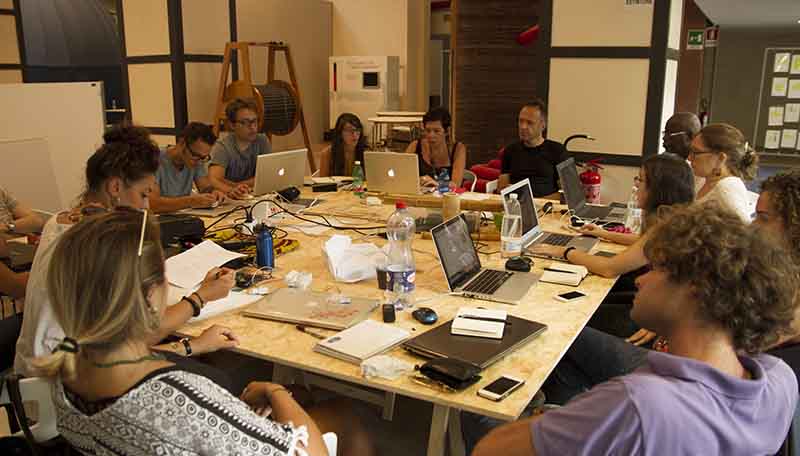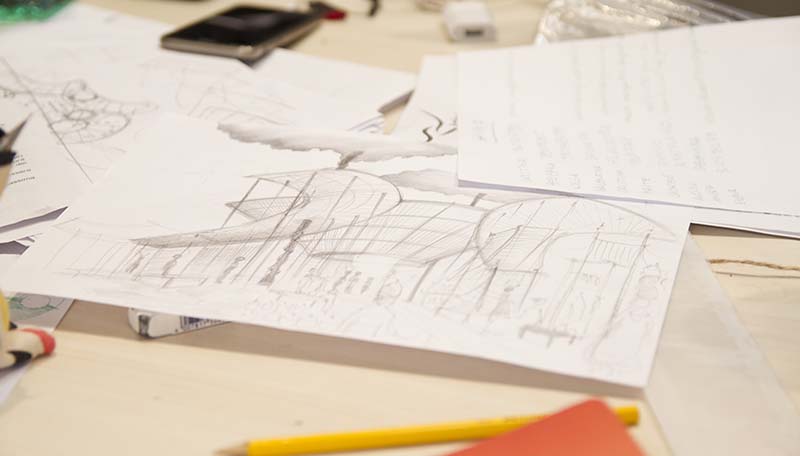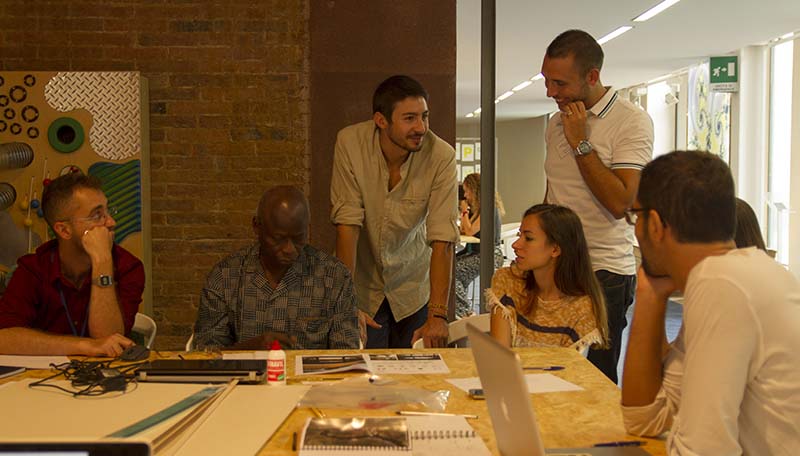HOW DO YOU WIN AN ARCHITECTURE COMPETITION?
by Sebastiano D'Urso
With all preambles out of the way, I have to admit without further ado that I have no idea how one would win an architecture competition. What I can humbly suggest, however, is how to compete in the best possible way. And the best way for a young designer is one that is at once fun and teachable. I am sorry to disappoint those who expected that the answer to the title question would be an enunciation of a truly winning approach. Regretfully, there is no recipe for winning an architecture competition. What is certain, however, is that, to stick to a culinary metaphor, some ingredients are fundamental. The must-have ingredients are: enthusiasm and the desire to design; a bit of courage and the ability to question oneself; the recognition of one’s own limits and the commitment to overcome them and, therefore, oneself; the predisposition to dialogue and the passion for architecture; and, the belief in one’s own idea, though comparing them with knowledge and know-how.
 As etymology has it, enthusiasm is being inspired, drawing energy from that very fire that never
goes out, and being eternally restless because you are never satisfied with what you do. Without
enthusiasm it is difficult, very difficult, to be able to do anything well; perhaps when it comes to
one’s job and, therefore, experience, you can do something even without enthusiasm, but to learn a
trade and hone experience you still need a little initial enthusiasm. In summary, embark upon a
project with enthusiasm and the conviction of what you are about to do, endeavoring to keep alive
that initial enthusiasm until the project has been delivered. The latter is not at all easy either, but,
then again, nothing is; none of the ingredients is easy to use either alone or combined with others.
The desire to design must be such that you can’t sleep at night and even when you can sleep, the
key is to keep your project in your dreams. This condition, which may appear excessive to those
who never experienced it, is customary for those who have ideas constantly whirling in their heads;
and when ideas whirl there is neither day nor night, neither wake nor sleep, but just whirling
thoughts. The desire to design is also this: having ideas and wanting to turn them into reality. In this
sense, the desire to design is a condition of the human spirit that affects everyone; however, those
who want to win an architecture competition must apply it to the main purpose of the competition.
Indeed, for those who have an immense desire to design, the competition is a means to designing
and it is not just the aim of designing. Designing for a designer is a continuous process that never
ends with the project, even upon its completion or if it stays merely on paper. Designing is a
continuous process made up of stages, namely the projects we commit ourselves to realize along the
way.
As etymology has it, enthusiasm is being inspired, drawing energy from that very fire that never
goes out, and being eternally restless because you are never satisfied with what you do. Without
enthusiasm it is difficult, very difficult, to be able to do anything well; perhaps when it comes to
one’s job and, therefore, experience, you can do something even without enthusiasm, but to learn a
trade and hone experience you still need a little initial enthusiasm. In summary, embark upon a
project with enthusiasm and the conviction of what you are about to do, endeavoring to keep alive
that initial enthusiasm until the project has been delivered. The latter is not at all easy either, but,
then again, nothing is; none of the ingredients is easy to use either alone or combined with others.
The desire to design must be such that you can’t sleep at night and even when you can sleep, the
key is to keep your project in your dreams. This condition, which may appear excessive to those
who never experienced it, is customary for those who have ideas constantly whirling in their heads;
and when ideas whirl there is neither day nor night, neither wake nor sleep, but just whirling
thoughts. The desire to design is also this: having ideas and wanting to turn them into reality. In this
sense, the desire to design is a condition of the human spirit that affects everyone; however, those
who want to win an architecture competition must apply it to the main purpose of the competition.
Indeed, for those who have an immense desire to design, the competition is a means to designing
and it is not just the aim of designing. Designing for a designer is a continuous process that never
ends with the project, even upon its completion or if it stays merely on paper. Designing is a
continuous process made up of stages, namely the projects we commit ourselves to realize along the
way.A little courage is necessary because sometimes, in order to be competitive, it is useful to dare, even beyond the requirements of a competition call. Countless competitions have seen as winners designers who have interpreted the call parameters, or even adjusted them where, in their opinion, they were inaccurate or hardly dispositive. To dare a lot, however, you must also risk a lot, because
 one of the main rules of the competitions is to respect the rules, under penalty of exclusion,
therefore missing the opportunity to see one’s ideas assessed, and feeling as all efforts were a waste
of time. Being courageous, therefore, does not have to mean, and this applies to very young
designers, to be presumptuous, because this attitude never pays off, or, if it does, it is a very rare
occurrence. Instead, having the courage to carry out your ideas in compliance with the rules of the
competition is always useful, if not to win the competition itself, at least to compare your ideas with
your competitors’.
One’s ability to question oneself does not only concern the comparison with other participants, but,
first of all, with oneself. A competition is a challenge that can put your self-esteem on the rocks, if
you really believe in what you are doing. But precisely in this sense, competitions are gyms that
allow young designers to free themselves from schooling and finally enter the competitive world of
design. If combined with the ability to question oneself, competition leads to a greater awareness of
one’s limits, which, can only be overcome in this way. When you reach this result, you have already
achieved a personal victory, regardless of whether you get prizes, recommendations or mentions in
your competition.
one of the main rules of the competitions is to respect the rules, under penalty of exclusion,
therefore missing the opportunity to see one’s ideas assessed, and feeling as all efforts were a waste
of time. Being courageous, therefore, does not have to mean, and this applies to very young
designers, to be presumptuous, because this attitude never pays off, or, if it does, it is a very rare
occurrence. Instead, having the courage to carry out your ideas in compliance with the rules of the
competition is always useful, if not to win the competition itself, at least to compare your ideas with
your competitors’.
One’s ability to question oneself does not only concern the comparison with other participants, but,
first of all, with oneself. A competition is a challenge that can put your self-esteem on the rocks, if
you really believe in what you are doing. But precisely in this sense, competitions are gyms that
allow young designers to free themselves from schooling and finally enter the competitive world of
design. If combined with the ability to question oneself, competition leads to a greater awareness of
one’s limits, which, can only be overcome in this way. When you reach this result, you have already
achieved a personal victory, regardless of whether you get prizes, recommendations or mentions in
your competition.Recognizing one’s own limits and committing to overcoming them and, by extension, oneself, springs from the approach by which you prepare for your architectural competition. Competitiveness is positive and constructive when it is based on study and knowledge and, therefore, when it requires sacrifice and commitment, as any great athlete aspiring to become a champion knows well.
The predisposition to dialogue is another way of comparing one’s limits and a good approach to prepare for an architecture competition: dialogue with colleagues; dialogue with places; dialogue with potential users and/or beneficiaries of the project; dialogue, dialogue and more dialogue. A dialogic approach is always procedural and can lead to the project as a result of an architectural process rather than a self-congratulatory practice or, at most, one for a restricted target audience. For those who want to try their hand at an architecture competition, indulge me in my reliance upon tautology, must have a boundless passion for architecture. I do not feel like exaggerating by
 adjectivizing the passion for architecture in this way; on the contrary, I feel plethoric when I say
that it takes a passion for architecture to participate in design competitions. Indeed, it should always
be like this, but it can also happen that you find yourself participating for different reasons, as
legitimate as they may be. And that is why I join Giò Ponti in suggesting that one has to “love
architecture”. Without love and care, it is impossible to be successful, because it is never us who
win but the love inspiring what we do. Thus, care and love - in an era in which this concept is also
dichotomized because it is either a taboo or it is inflated - are two other ingredients of our recipe.
However, having ideas is not enough to be “competitive”. It is necessary to believe in one’s own
ideas, without sinning in the belief of having to be original at all costs. To save us from this last risk
is once again comparison or, put it another way, knowledge: one’s ideas, especially those of very
young designers, must be compared with the different knowledge that contribute to define an
architectural project, and, above all, with the knowledge of history in general and of architecture in
particular. This is how we realize that it is very difficult to be original because, as I often say,
everything or almost everything has already been done before, even better than we can. All this is
left to do, is try to be authentic.
I could go on saying things that are obvious and not at all practical, which those who started reading
this essay probably expected, intrigued by my high-sounding title. But I don’t want to dwell on a
piece that begins to look like a sermon, which I therefore wrap up by saying that there are still many
other ingredients that each of you can and may want to add, and which, combined with the ones I
suggest, will help you become a designer and not just complete a project.
adjectivizing the passion for architecture in this way; on the contrary, I feel plethoric when I say
that it takes a passion for architecture to participate in design competitions. Indeed, it should always
be like this, but it can also happen that you find yourself participating for different reasons, as
legitimate as they may be. And that is why I join Giò Ponti in suggesting that one has to “love
architecture”. Without love and care, it is impossible to be successful, because it is never us who
win but the love inspiring what we do. Thus, care and love - in an era in which this concept is also
dichotomized because it is either a taboo or it is inflated - are two other ingredients of our recipe.
However, having ideas is not enough to be “competitive”. It is necessary to believe in one’s own
ideas, without sinning in the belief of having to be original at all costs. To save us from this last risk
is once again comparison or, put it another way, knowledge: one’s ideas, especially those of very
young designers, must be compared with the different knowledge that contribute to define an
architectural project, and, above all, with the knowledge of history in general and of architecture in
particular. This is how we realize that it is very difficult to be original because, as I often say,
everything or almost everything has already been done before, even better than we can. All this is
left to do, is try to be authentic.
I could go on saying things that are obvious and not at all practical, which those who started reading
this essay probably expected, intrigued by my high-sounding title. But I don’t want to dwell on a
piece that begins to look like a sermon, which I therefore wrap up by saying that there are still many
other ingredients that each of you can and may want to add, and which, combined with the ones I
suggest, will help you become a designer and not just complete a project.The author: Sebastiano D'Urso
Assistant professor of Architectural and Urban Composition at DICAR. He has taken his PhD in “Design and architectural urban and environmental restoration” at the University of Catania. He has organized and entered many national and international design workshop both in Italy and abroad. As for the research, he has dealt with modernity in architecture and with its languages and their contamination with other arts. He has turned himself towards the search for contemporary dwelling sense, investigating the conditions and the places where it occurs. Moreover, in the research he deals with aesthetic issues related to sustainability. He is author of 6 books and many book chapters, and author or co-author of several papers published on national and international conference proceedings.
